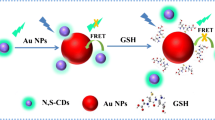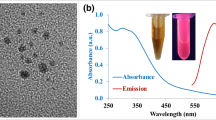Abstract
Using two-dimensional (2D) nickel-based metal organic framework (Ni-MOF) nanosheets as a matrix, Eu3+ and Ag+ were incorporated to synthesize Ag/Eu@Ni-MOF with double luminescence centers of Eu3+ ion (615 nm) and organic ligand (524 nm). And a ratiometric luminescence sensor is constructed based on Ag/Eu@Ni-MOF for sensitive detection of biothiols in aqueous solutions. The dual-emissive fluorescence properties can be tuned by changing the amounts of Ag+ ions doping. The results of temperature and pH effects on the fluorescence of Ag/Eu@Ni-MOF indicates that the Ag/Eu@Ni-MOF is a temperature-sensitive material and the fluorescence of Ag/Eu@Ni-MOF can keep stable over a wide pH range. Due to the binding of -SH in cysteine (Cys) and glutathione (GSH) with Ag+, the ligand luminescence was significantly inhibited by weakening the Ag + influence on the energy transfer process in the MOFs. Therefore, ratiometric fluorescent sensing of biomolecular thiols was realized based on the dual-emission Ag/Eu@Ni-MOF. More importantly, the fluorescence color change can be observed with naked eyes to realize visual detection. The ratiometric fluorescent sensor exhibits high performance for Cys and GSH detection with a wide linear range of 5-250 µM and a relatively low detection limit of 0.20 µM and 0.17 µM, respectively. Furthermore, the biothiols content in human serum was determined with satisfactory results. It proves the Ni-MOF nanosheets can be used as a stable matrix for construction luminescent MOFs for the first time, and validate the great potential of Ag/Eu@Ni-MOF as a ratiometric fluorescent probe for point-of-care testing (POCT) in disease diagnosis.





Similar content being viewed by others
Data Availability
All data generated or analyzed during this study are included in this published article.
References
Zhang S, Ong CN, Shen HM (2004) Critical roles of intracellular thiols and calcium in parthenolide-induced apoptosis in human colorectal cancer cells. Cancer Lett 208:143–153. https://doi.org/10.1016/j.canlet.2003.11.028
Lugrin J, Rosenblatt-Velin N, Parapanov R et al (2014) The role of oxidative stress during inflammatory processes. Biol Chem 395:203–230. https://doi.org/10.1515/hsz-2013-0241
Kleinman WA, Richie JP (2000) Status of glutathione and other thiols and disulfides in human plasma. Biochem Pharmacol 60:19–29. https://doi.org/10.1016/s0006-2952(00)00293-8
Su D, Teoh CL, Sahu S et al (2014) Live cells imaging using a turn-on FRET-based BODIPY probe for biothiols. Biomaterials 35:6078–6085. https://doi.org/10.1016/j.biomaterials.2014.04.035
Xu J, Yu H, Hu Y et al (2016) A gold nanoparticle-based fluorescence sensor for high sensitive and selective detection of thiols in living cells. Biosens Bioelectron 75:1–7. https://doi.org/10.1016/j.bios.2015.08.007
Zhang S, Wu D, Jiang X et al (2019) A novel fluorescent probe with one-excitation and dual-emission for selective and simultaneous detection of Glutathione and Arginine in NIR and blue regions. Sens Actuators B 290:691–697. https://doi.org/10.1016/j.snb.2019.04.028
Ivanov AV, Bulgakova PO, Virus ED et al (2017) Capillary electrophoresis coupled with chloroform-acetonitrile extraction for rapid and highly selective determination of cysteine and homocysteine levels in human blood plasma and urine. Electrophoresis 38:2646–2653. https://doi.org/10.1002/elps.201700133
Michelet F, Gueguen R, Leroy P et al (1995) Blood and plasma glutathione measured in healthy subjects by HPLC: Relation to sex, aging, biological variables, and life habits. Clin Chem 41:1509–1517
Xiao HM, Wang X, Liao QL et al (2019) Sensitive analysis of multiple low-molecular-weight thiols in a single human cervical cancer cell by chemical derivatization-liquid chromatography-mass spectrometry. Analyst 144:6578–6585. https://doi.org/10.1039/c9an01566c
Mu S, Yang Y (2016) Recognition of glutathione based on its electrocatalytic oxidation on the bare fluorine doped tin oxide electrode. J Electroanal Chem 780:12–18. https://doi.org/10.1016/j.jelechem.2016.08.038
Mu S, Shi Q (2016) Photoelectrochemical properties of bare fluorine doped tin oxide and its electrocatalysis and photoelectrocatalysis toward cysteine oxidation. Electrochim Acta 195:59–67. https://doi.org/10.1016/j.electacta.2016.02.139
Jung HS, Chen X, Kim JS et al (2013) Recent progress in luminescent and colorimetric chemosensors for detection of thiols. Chem Soc Rev 42:6019–6031. https://doi.org/10.1039/c3cs60024f
Sun Y, Zuo T, Guo F et al (2017) Perylene dye-functionalized silver nanoparticles serving as pH-dependent metal sensor systems. RSC Adv 7:24215–24220. https://doi.org/10.1039/c7ra03264a
Li Y, Feng J, Huang Y et al (2020) Upconverting ion-selective nanoparticles for the imaging of intracellular calcium ions. Analyst 145:4768–4771. https://doi.org/10.1039/d0an00454e
Xu Q, Wei HP, Hu XY (2013) Glutathione detection based on ZnS quantum-dot-based OFF-ON fluorescent probe. Chin J Anal Chem 41:1102–1106. https://doi.org/10.3724/sp.J.1096.2013.21154
Shu Y, Gao JL, Chen JY et al (2021) A near-infrared fluorescent sensor based on the architecture of low-toxic Ag2S quantum dot and MnO2 nanosheet for sensing glutathione in human serum sample. Talanta 221:7. https://doi.org/10.1016/j.talanta.2020.121475
Furukawa H, Cordova KE, O’keeffe M et al (2013) The chemistry and applications of metal-organic frameworks. Science 341:1230444. https://doi.org/10.1126/science.1230444
Cui YJ, Yue YF, Qian GD et al (2012) Luminescent functional metal-organic frameworks. Chem Rev 112:1126–1162. https://doi.org/10.1021/cr200101d
Shu Y, Ye Q, Dai T et al (2021) Encapsulation of luminescent guests to construct luminescent metal-organic frameworks for chemical sensing. ACS Sens 6:641–658. https://doi.org/10.1021/acssensors.0c02562
Yan B (2017) Lanthanide-Functionalized metal-organic framework hybrid systems to create multiple luminescent centers for chemical sensing. Acc Chem Res 50:2789–2798. https://doi.org/10.1021/acs.accounts.7b00387
Talapin DV, Rogach AL, Kornowski A et al (2001) Highly luminescent monodisperse CdSe and CdSe/ZnS nanocrystals synthesized in a hexadecylamine – trioctylphosphine oxide – trioctylphospine mixture. Nano Lett 1:207–211. https://doi.org/10.1021/nl0155126
Dong MJ, Zhao M, Ou S et al (2014) A luminescent dye@MOF platform: emission fingerprint relationships of volatile organic molecules. Angew Chem Int Edit 53:1575–1579. https://doi.org/10.1002/anie.201307331
Chen R, Zhang J, Chelora J et al (2017) Ruthenium(II) complex incorporated UiO-67 metal-organic framework nanoparticles for enhanced two-photon fluorescence imaging and photodynamic cancer therapy. ACS Appl Mater Interfaces 9:5699–5708. https://doi.org/10.1021/acsami.6b12469
Lustig WP, Mukherjee S, Rudd ND et al (2017) Metal-organic frameworks: functional luminescent and photonic materials for sensing applications. Chem Soc Rev 46:3242–3285. https://doi.org/10.1039/c6cs00930a
Zhang J, Huang Y, Yue D et al (2018) A luminescent turn-up metal-organic framework sensor for tryptophan based on singlet-singlet Forster energy transfer. J Mater Chem B 6:5174–5180. https://doi.org/10.1039/c8tb01592a
Yan B (2021) Luminescence response mode and chemical sensing mechanism for lanthanide-functionalized metal–organic framework hybrids. Inorg Chem Front 8:201–233. https://doi.org/10.1039/d0qi01153c
Hao JN, Yan B (2016) A dual-emitting 4d-4f nanocrystalline metal-organic framework as a self-calibrating luminescent sensor for indoor formaldehyde pollution. Nanoscale 8:12047–12053. https://doi.org/10.1039/c6nr02446g
Bunzli JC, Piguet C (2005) Taking advantage of luminescent lanthanide ions. Chem Soc Rev 34:1048–1077. https://doi.org/10.1039/b406082m
Zhou Y, Yan B (2015) Ratiometric detection of temperature using responsive dual-emissive MOF hybrids. J Mater Chem C 3:9353–9358. https://doi.org/10.1039/c5tc02004b
Zhang Y, Li B, Ma H et al (2016) Rapid and facile ratiometric detection of an anthrax biomarker by regulating energy transfer process in bio-metal-organic framework. Biosens Bioelectron 85:287–293. https://doi.org/10.1016/j.bios.2016.05.020
Yang J, Xiong P, Zheng C et al (2014) Metal–organic frameworks: a new promising class of materials for a high performance supercapacitor electrode. J Mater Chem A 2:16640–16644. https://doi.org/10.1039/c4ta04140b
Yang J, Zheng C, Xiong P et al (2014) Zn-doped Ni-MOF material with a high supercapacitive performance. J Mater Chem A 2:19005–19010. https://doi.org/10.1039/c4ta04346d
Zhang X, Fang L, Jiang K et al (2019) Nanoscale fluorescent metal-organic framework composites as a logic platform for potential diagnosis of asthma. Biosens Bioelectron 130:65–72. https://doi.org/10.1016/j.bios.2019.01.011
Decadt R, Van Hecke K, Depla D et al (2012) Synthesis, crystal structures, and luminescence properties of carboxylate based rare-earth coordination polymers. Inorg Chem 51:11623–11634. https://doi.org/10.1021/ic301544q
Rocha J, Carlos LD, Paz FA et al (2011) Luminescent multifunctional lanthanides-based metal-organic frameworks. Chem Soc Rev 40:926–940. https://doi.org/10.1039/c0cs00130a
Sergeeva NN, Donnier-Marechal M, Vaz G et al (2011) Synthesis and evaluation of the europium(III) and zinc(II) complexes as luminescent bioprobes in high content cell-imaging analysis. J Inorg Biochem 105:1589–1595 https://doi.org/10.1016/j.jinorgbio.2011.08.023
Gutiérrez M, Martín C, Souza BE et al (2020) Highly luminescent silver-based MOFs: Scalable eco-friendly synthesis paving the way for photonics sensors and electroluminescent devices. Appl Mater Today 21. https://doi.org/10.1016/j.apmt.2020.100817
Reineke TM, Eddaoudi M, Fehr M et al (1999) From condensed lanthanide coordination solids to microporous frameworks having accessible metal sites. J Am Chem Soc 121:1651–1657. https://doi.org/10.1021/ja983577d
Sun D, Cao R, Bi W et al (2004) Syntheses and characterizations of a series of silver-carboxylate polymers. Inorg Chim Acta 357:991–1001. https://doi.org/10.1016/j.ica.2003.10.010
Dong XY, Huang HL, Wang JY et al (2018) A flexible fluorescent SCC-MOF for switchable molecule identification and temperature display. Chem Mat 30:2160–2167. https://doi.org/10.1021/acs.chemmater.8b00611
Ma X, Guo Q, Xie Y et al (2016) Green chemistry for the preparation of L-cysteine functionalized silver nanoflowers. Chem Phys Lett 652:148–151. https://doi.org/10.1016/j.cplett.2016.04.004
Darroudi M, Ahmad MB, Shameli K et al (2009) Synthesis and characterization of UV-irradiated silver/montmorillonite nanocomposites. Solid State Sci 11:1621–1624. https://doi.org/10.1016/j.solidstatesciences.2009.06.016
Acknowledgements
We gratefully acknowledge the financial support from the NSFC (Nos. 21705141, 22076161, 21675140, 21575124), the Green Yang Jinfeng Talent Project of Yangzhou.
Funding
No funding was received for conducting this study.
Author information
Authors and Affiliations
Contributions
Yun Shu: Conceptualization, Supervision, Methodology, Writing–review & editing, Project administration. Tao Dai: Conceptualization, Methodology, Writing-original draft, Formal analysis. Qiuyu Ye: Data curation, Investigation. Dangqin Jin: Investigation. Qin Xu: Visualization, Investigation. Xiaoya Hu: Supervision, Funding acquisition.
Corresponding authors
Ethics declarations
Ethics Approval
Not applicable.
Consent to Participate
Not applicable.
Consent for Publications
Not applicable.
Conflict of Interest
The authors declare no competing financial interest.
Additional information
Publisher’s Note
Springer Nature remains neutral with regard to jurisdictional claims in published maps and institutional affiliations.
Supplementary Information
Below is the link to the electronic supplementary material.
Rights and permissions
About this article
Cite this article
Shu, Y., Dai, T., Ye, Q. et al. A Dual-emitting Two-dimensional Nickel-based Metal-organic Framework Nanosheets: Eu3+/Ag+ Functionalization Synthesis and Ratiometric Sensing in Aqueous Solution. J Fluoresc 31, 1947–1957 (2021). https://doi.org/10.1007/s10895-021-02826-w
Received:
Accepted:
Published:
Issue Date:
DOI: https://doi.org/10.1007/s10895-021-02826-w




